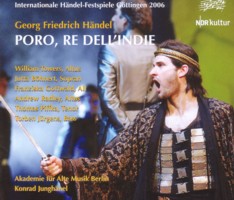Much has been said and
written about Handel and Metastasio, and the composer’s supposed lack of
interest in the librettos of the famous Roman poet. The fact is that Handel
generally used adaptations of much older librettos which perhaps represented
a bigger space of liberty for its work and conception of drama. Though
Handel set to music only three librettos by Metastasio (Siroe,
Poro and Ezio), we can hardly doubt he knew and recognised the
qualities of their dramaturgy. Two of the three were successful and all of
them gave him opportunity to write beautiful music. Furthermore, we should
keep in mind that Handel used four other librettos by Metastasio for
pasticcios (Catone, Semiramide, Arbace and Didone
abbandonata) and that his interest was quite early as Metastasio
wrote his first opera librettos only in the mid 1720s. Before Handel set
Siroe, re di Persia to music in 1728, it had only been set by Leonardo
Vinci (1726), Nicola Porpora (1727), Domenico Sarrò (1727) and Antonio
Vivaldi (1727), and Siroe was only Metastasio’s second drama per
musica.
First performed on February
1731, Poro re dell’Indie is based on the libretto Alessandro
nell’Indie, Metastasio’s sixth drama per musica. It was first
set to music in Rome by Vinci in 1729 (with Carestini as Poro), and then by
Giovanni Battista Pergolesi in 1730. Hasse’s and Porpora’s settings were
both created in 1731. The original libretto was dedicated to ‘Giacomo III
re della Gran Bretagna’ (i.e. James (III) Stuart, the ‘old pretender’),
a dedication which was probably not known to Handel’s audience!
Alessandro nell’Indie was one of the most successful librettos by
Metastasio and was set to music – and adapted – more than sixty times during
the eighteenth century. One of the changes concerns the title which can be
the original Alessandro (Vinci, Pergolesi among others) or Poro
(Handel, Porpora) or Cleofide (Hasse). The name of the character used
in the title is not necessarily a sign of who is the main character. In
opera seria – and Metastasian – dramaturgy there is almost always a main
couple of lovers, the primo uomo and the prima donna, who are
here definitely Poro and Cleofide. Other usual figures are a second couple
(often of lovers too; here they are Erissena and Gandarte), a bad guy (Timagene)
and a particular one, the king. This character can take different forms. His
particular situation – not belonging to one of the couples though he can be
in love with a member of them – results in several possible uses for him:
sometimes as a less vital secondary character, often an essential associate
character with a vital function in the story, and sometimes as a more
prominent figure, as with Alessandro in Poro. Such a character is
often but not always an old one, more or less a good one. Here the figure of
the king is fulfilled by Alessandro (the historical figure of the Macedonian
king Alexander the great), who is definitely young, heroic, fair and good.
The choice of the title can just be a way to pay homage to the dedicatee
(James III Stuart associated with Alexander the great) or could be a way to
satisfy the ego of the main singer (in Handel’s case, Poro was sung by
Senesino).
There are very few
recordings of this opera: Hans Margraf recorded it in the early 1960s, in
German and with parts transposed (published on CD on Berlin Classics); more
recently, Fabio Biondi recorded Poro in the mid 1990’s for Opus 111,
with globally a very good cast, stronger than Junghänel’s, but with much
less rigour in his approach to the score. This new semi-commercial recording
from the Göttingen festival is once more particularly welcome as it could be
the most satisfying recording yet. It is basically the February 1731 version
with the addition of a scene from the November 1731 revival to give a better
balance to the whole and more consistency to the part of Timagene, slightly
neglected before because of a singer which seemed of limited capacities (in
November 1731, the role of Timagene was expanded for Antonio Montagnana).
The achievement of this
recording is mainly how it is very well balanced. The Akademie für Alte
Musik is always excellent, and Konrad Junghänel’s conducting can suffer very
few reproaches (perhaps only an infrequent lack of finesse). There is
nothing exceptional from the singers but almost all of them offer good or
very good performances; some weaknesses you can hear at the beginning tend
to disappear during the evening. Style, emotion and commitment are never
neglected. The most problematic performance is due to the tenor (as before
with Biondi’s version). Although Thomas Piffka makes many efforts not to
scream, his singing is quite average, lacks legato, and his Italian is
sometimes quite approximate. Jutta Böhnert is a nice Cleofide, and though
William Towers sometimes tries too hard with his highest notes, he shows
really interesting potential.


